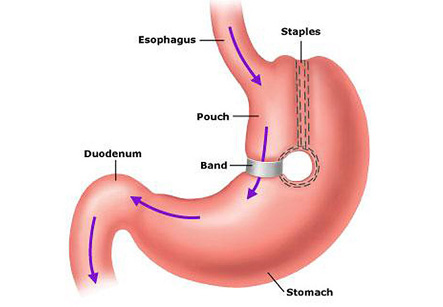Vertical Banded Gastroplasty
Introduction
Vertical-banded gastroplasty is commonly known as stomach stapling or a sleeve gastroplasty. It is a restrictive weight loss surgery that works by decreasing the amount of food that the patient is able to consume before feeling full. This surgery combines the aspects of stomach stapling and gastric banding, but it is not adjustable.
The intestine is not bypassed in this procedure and there is no change in the way the body digests food in the intestines.
In this surgery, a small section of the stomach is isolated for processing food, the size of meals is limited to approximately one ounce, and digestion is slowed by forcing the food to pass through a restrictive ring. The lap-band surgery also uses a restrictive ring, but these surgeries are very different. The lap band requires no incisions on the stomach while vertical-banded gastroplasty creates a puncture in the stomach for the band to loop through. Another feature of the lap-band is that it can be adjusted as needed without surgery, but the restrictive band in vertical-banded gastroplasty cannot be modified without surgery.
The surgery is not a cure for obesity. The patient who undergoes this procedure must make radical changes in their food intake and lifestyle in order for the procedure to be successful over a long term. As the stomach has the ability to stretch to accommodate food, the stomach can expand greatly from the one ounce capacity. Meals should be very small after surgery and drinking fluids with meals can fill up the pouch.
We have all the information you need about public and private clinics and hospitals that provide weight loss surgeries in Iran, Islamic Republic Of with the best quality and lowest possible prices

The Procedure
1. The surgery is typically performed in a hospital or a surgery center, under general anesthesia.
2. The surgery is done by inserting a tiny camera and small instruments in the abdomen. This type of surgery is called as laparoscopy. This avoids opening up of the abdominal cavity and also prevents a large scar.
3. In some cases, an open surgery is performed with larger traditional incision. Sometimes, a surgery that begins laparoscopically may be converted to the open procedure when the surgeon determines it to be necessary.
4. The surgery begins with taking multiple half-inch-long incisions or ports in the area of the stomach. The instruments are inserted through these incisions.
5. After this, the surgeon begins by making an incision in the stomach. The sides of the incision are stapled, thus creating a hole in the stomach through which a restrictive band can be threaded. This band decreases the speed with which food can leave the stomach.
6. The stomach is stapled above the newly created hole which forces the digested food to leave the stomach through the banded area. As the procedure is completed, the area of the stomach that digests food holds an ounce of food or less.
7. Now, the surgeon determines that the staples are holding the stomach closed and there are no areas which appear to leak. As this is confirmed, the instruments are withdrawn and the incisions are closed, usually with sterile tape.
Possible Complications
If a gastroplasty is being planned, the doctor will discuss the possible complications with the patient, which may include:
1. Vitamin deficiencies— a multivitamin needs to be taken daily for the rest of the life.
2. Infection
3. Bleeding
4. Blood clots
5. Vomiting
6. Breakdown of the staples, allowing stomach juices to leak into the abdomen
7. Slipping of the band
8. Enlargement of the pouch
9. Irritation of the throat due to acid reflux
10. Hernia formation
11. Risks of general anesthesia
Factors which can increase the risk of complications include:
1. Smoking
2. Recent or chronic illness (eg, kidney disease)
3. Diabetes
4. Heart or lung disease
5. Old age
6. Bleeding or clotting disorders
Results:
This procedure has variable results in the long term. The results can vary from regaining all of the lost weight to maintaining 50 percent of total weight lost. Many patients have difficulty to maintain the tiny portions required to keep the stomach pouch size small. When they begin to consume larger portions, the weight loss stops and weight gain often begins.
The intestine is not bypassed in this procedure and there is no change in the way the body digests food in the intestines. Therefore, there is no risk of malnutrition due to the surgery.
Total weight loss and long-term weight maintenance is the lowest for this type of surgery when compared to all other types of bariatric surgery currently being performed. Hence, it is not recommended for people with a very large amount of weight to lose and also for the patients who are candidates for other procedures.